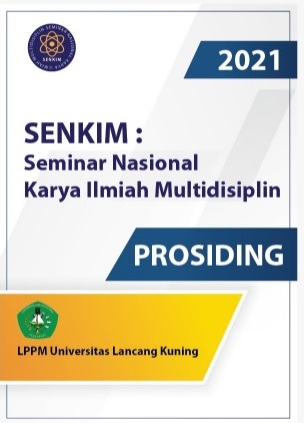Kandungan Kimia Crude Bio Oil Tandan Kosong Kelapa Sawit Sebagai Bahan Baku Bioenergi
Abstract
Bio oil is the result of pyrolysis in the form of a dark liquid containing the main chemical compounds such as hydrocarbon compounds, aromatic compounds, aliphatic, other organic compounds using plant biomass as raw materials. Empty fruit bunches ( EFB) is a bioenergy product that can be an environmentally friendly fuel, and a substitute for fossil fuel energy in the future. This study aims to determine the content of hydrocarbon compounds in crude bio oil EFB through the hydrothermal pyrolysis process. The content of chemical compounds was analyzed using the GC – MS (Agylent Technology) Analyzer. The results of the analysis of GCMS bio oil obtained hydrocarbon compounds , aromatic compounds, aliphatic and other organic compounds. There were 19 types of hydrocarbon compounds with a total percentage of 15.24%.
Abstrak
Bio oil merupakan hasil proses pirolisis berupa cairan berwarna gelap yang mengandung senyawa kimia utama seperti senyawa hidrokarbon, senyawa aromatik, alifatik, senyawa organik lainnya dengan menggunakan bahan baku biomassa tanaman. Bio oil tandan kosong kelapa sawit ( TKKS) merupakan produk bioenergi yang dapat menjadi bahan bakar ramah lingkungan dan pengganti energi bahan bakar fosil di masa depan. Penelitian ini bertujuan untuk mengetahui kandungan senyawa hidrokarbaon crude bio oil TKKS melalui proses pirolisis hidrotermal. Kandungan senyawa kimia dianalisis dengan alat Analyser GC – MS (Agylent Technology). Hasil analisis GC-MS bio oil diperoleh senyawa hidrokarbon senyawa aromatik, alifatik dan senyawa organik lainnya. Senyawa hidrokarbon ditemukan 19 jenis dengan persentase total 15,24%.
References
Abnisa F, Daud WMAW, Sahu JN. (2011). Optimization and characterization studies on bio-oil production from palm shell by pyrolysis using response surface methodology. Biomass and Bioenergy. 35(8) 3604–3616. doi:10.1016/j.biombioe.2011.05.011
Basu P. (2013). Biomass Gasification, Pyrolysis and Torrefaction. Practical Design and Theory diedit oleh second Edition. India: Elsevier.
Bridgwater A V. (2012). Review of fast pyrolysis of biomass and product upgrading. Biomass and Bioenergy. 38: 68–94. doi:10.1016/j.biombioe.2011.01.048
Bardalay M and Mahanta DK. (2015). A Review of Physical Properties of Biomass Pyrolysis Oil. International Journal of Renewable Energy Research. 5 (1) : 1 - 10.
[BPS] Badan Pusat Statistik. (2017). Statistik Kelapa Sawit Indonesia. Jakarta (ID).
Caprariis B, De Filippis P, Petrullo A, Scarsella M. (2017). Hydrothermal liquefaction of biomass: Influence of temperature and biomass composition on the bio-oil production. Fuel. 208 618–625. doi:10.1016/j.fuel.2017.07.054
Chang SH. (2014). An overview of empty fruit bunch from oil palm as feedstock for bio-oil production. Biomass and Bioenergy. 62 174–181. doi:10.1016/j.biombioe.2014.01.002
Choi GG, Oh SJ, Lee SJ, Kim JS. (2015). Production of bio-based phenolic resin and activated carbon from bio-oil and biochar derived from fast pyrolysis of palm kernel shells. Bioresour. Technol. 178 99–107. doi:10.1016/j.biortech.2014.08.053
Chiaramonti, David, Prussi, Matteo,Buffi, Rizzo M, Maria A. (2017). Review and experimental study on pyrolysis and hydrothermal liquefaction of microalgae for Biofuel Production. Applied Energy. 185: 963-972. doi 10.1016/j.apenergy.2015.12.001.
Kim SJ, Jung SH, Kim JS. (2010). Fast pyrolysis of palm kernel shells: Influence of operation parameters on the bio-oil yield and the yield of phenol and phenolic compounds. Bioresour. Technol. 101(23) 9294–9300. doi:10.1016/j.biortech.2010.06.110
Mattjik AA, Sumertajaya M. (2000). Perancangan Percobaan dengan Aplikasi SAS dan Minitab Jilid I 1. Bogor (ID): IPB Pr.
Mazaheri H, Lee KT, Bhatia S, Mohamed AR. (2010). Sub/supercritical liquefaction of oil palm fruit press fiber for the production of bio-oil: Effect of solvents. Bioresour. Technol. 101(19) 7641–7647. doi:10.1016/j.biortech.2010.04.072
Novianti S, Biddinika MK, Prawisudha P, Yoshikawa K. (2014). Upgrading of Palm Oil Empty Fruit Bunch Employing Hydrothermal Treatment in Lab-scale and Pilot Scale. Procedia Environ. Sci. 20 46–54. doi:10.1016/j.proenv.2014.03.008
Oramahi HA, Wahdina, Diba F, Nurhaida, Yoshimura T. (2015). Optimization of Production of Lignocellulosic Biomass Bio-oil from Oil Palm Trunk. Procedia Environ. Sci. 28(SustaiN 2014) 769–777. doi:10.1016/j.proenv.2015.07.090
Patwahdan PR. (2010). Understanding the product distribution from biomass fast pyrolysis [Dissertation]. Lowa (USA): Lowa University.
Sulaiman F, Abdullah N. (2011). Optimum conditions for maximising pyrolysis liquids of oil palm empty fruit bunches. Energy. 36(5) 2352–2359. doi:10.1016/j.energy.2010.12.067
Xiu A, Shahbazi A, Shirley V, Cheng D. (2010). Hydrothermal Pyrolysis of Swine Manure to Bio Oil: Effects of Operating Parameters on Products Yield and Characterization of Bio Oil. Analytical and Applied Pyrolysis 88: 73 - 79. doi: 10.1016/j.jap.2010.02.011
Xiu S, Shahbazi A. (2012). Bio-oil production and upgrading research: A review. Renew. Sustain. Energy Rev. 16(7) 4406–4414. doi:10.1016/j.rser.2012.04.028
Yang H, Yan R, Chen H, Lee DH, Zheng C. (2007). Characteristics of hemicellulose, cellulose and lignin pyrolysis. Fuel. 86(12–13) 1781–1788. doi:10.1016/j.fuel.2006.12.013
Yang L, Nazari L, Yuan Z, Corscadden K, Xu CC, He QS. (2016) Hydrothermal liquefaction of spent coffee grounds in water medium for bio-oil production. Biomass and Bioenergy. 86 191–198. doi:10.1016/j.biombioe.2016.02.005



